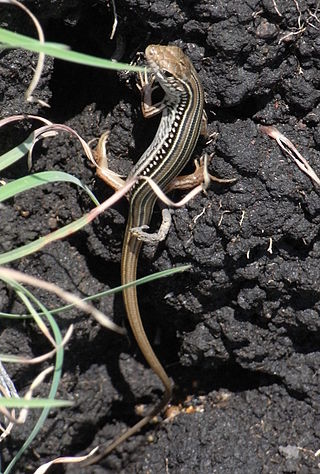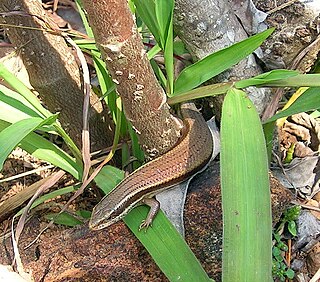
Skinks are lizards belonging to the family Scincidae, a family in the infraorder Scincomorpha. With more than 1,500 described species across 100 different taxonomic genera, the family Scincidae is one of the most diverse families of lizards. Skinks are characterized by their smaller legs in comparison to typical lizards and are found in different habitats except arctic and subarctic regions.

Anomalopus is a genus of worm-skinks, smallish smooth-scaled burrowing lizards in the subfamily Sphenomorphinae of the family Scincidae. The genus is endemic to the eastern half of Australia. The genus belongs to a clade in the Sphenomorphus group which contains such genera as Ctenotus and the close relatives Eulamprus and Gnypetoscincus.

Acritoscincus is a genus of Australian skinks. It belongs to the Eugongylus group; the genus Oligosoma appears to be a fairly close relative. An alternative name is Bassiana.

Ctenotus is a genus of skinks, lizards in the family Scincidae. The genus is endemic to Australia. The genus Ctenotus belongs to a clade in the Sphenomorphus group which contains such genera as Anomalopus and the close relatives Eulamprus and Gnypetoscincus.

Eremiascincus is a genus of skinks, lizards in the family Scincidae. The genus is endemic to Australia, Indonesia, and East Timor.

The earless skinks form the genus Hemiergis in the skink family Scincidae. All earless skinks are native to Australia. They are also called mulch skinks.
Janetaescincus is a genus of burrowing skinks in the family Scincidae. The genus is endemic to the Seychelles. There are two recognized species.

Lampropholis is a genus of skinks, commonly known as sunskinks, in the lizard subfamily Eugongylinae of the family Scincidae. The genus Lampropholis was previously found to belong to a clade with the genera Niveoscincus, Leiolopisma and others of the Eugongylus group within Lygosominae. All species of Lampropholis are endemic to Australia. For similar skinks see genera Bassiana, Pseudemoia, and Niveoscincus.

Blue-tongued skinks comprise the Australasian genus Tiliqua, which contains some of the largest members of the skink family (Scincidae). They are commonly called blue-tongued lizards or simply blue-tongues or blueys in Australia or panana in Indonesia. As suggested by these common names, a prominent characteristic of the genus is a large blue tongue that can be bared as bluff-warning to potential enemies. Their tongue can also deform itself and produce a thick mucus in order to catch prey. They are relatively shy in comparison with other lizards, and also significantly slower due to their shorter legs.
The giant spiny skink or Poncelet's helmet skink is a species of lizard in the family Scincidae. The species is endemic to the Solomon Islands.

Lygosominae is the largest subfamily of skinks in the family Scincidae. The subfamily can be divided into a number of genus groups. If the rarely used taxonomic rank of infrafamily is employed, the genus groups would be designated as such, but such a move would require a formal description according to the ICZN standards.

The fire skink, also known commonly as Fernand's skink, the Togo fire skink, and the true fire skink, is a fairly large skink, a species of lizard in the family Scincidae. The species is known for its bright and vivid coloration. Native to tropical forests in West and Central Africa, the fire skink lives fifteen to twenty years. This species is a diurnal lizard that burrows and hides. It is relatively shy and reclusive, but may become tame in captivity.
Epibator greeri, also known commonly as Greer's tree skink, is a species of lizard in the family Scincidae. The species is endemic to New Caledonia.
Mochlus grandisonianus, also known commonly as Lanza's writhing skink, is a species of lizard in the family Scincidae. The species is endemic to Somalia.
Anomalopus leuckartii, also known commonly as Leuckart's burrowing skink and the two-clawed worm-skink, is a species of lizard in the subfamily Sphenomorphinae of the family Scincidae. The species is native to eastern Australia.

Eremiascincus brongersmai, also known commonly as Brongersma's tree skink and the brown-sided bar-lipped skink, is a species of lizard in the family Scincidae. The species is endemic to the state of Western Australia.
Eremiascincus butlerorum is a species of skink, a lizard in the family Scincidae. The species is endemic to the island of Sumba in Indonesia.
The ghost skink is a species of skink endemic to Australia.

The broad-banded sand-swimmer or Richardson's skink is a species of skink found in Australia.

Chalcides bottegi, also known commonly as Bottego's cylindrical skink or the ocellated skink, is a species of lizard in the family Scincidae. The species is native to East Africa, the Horn of Africa, and Northeast Africa.











